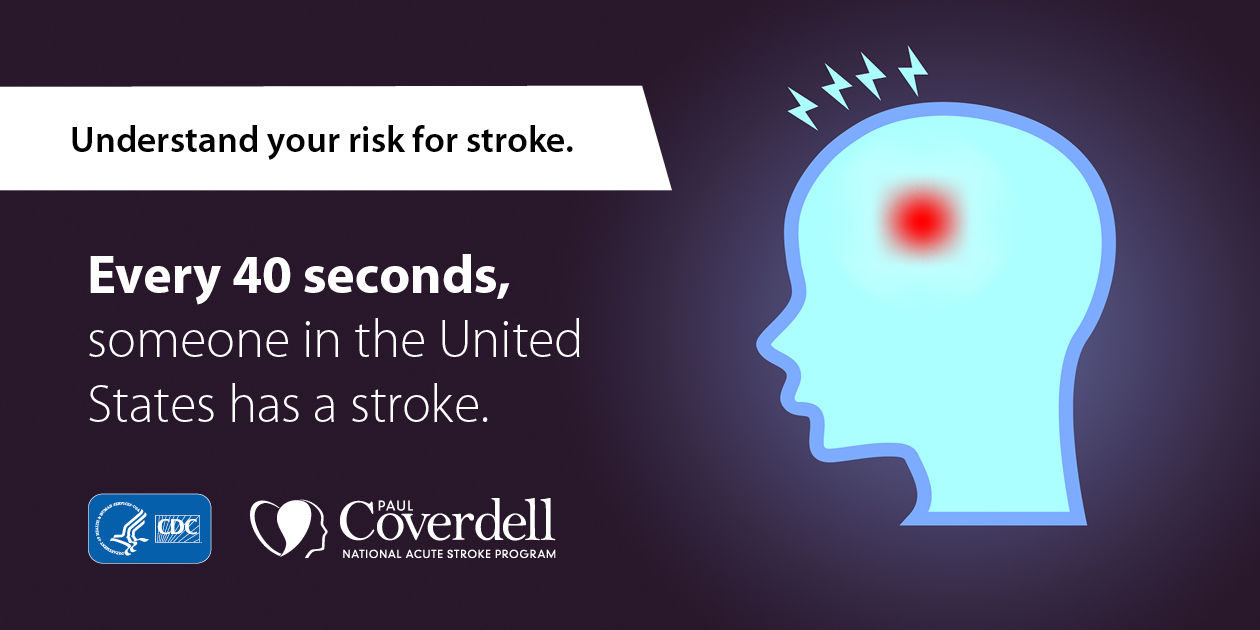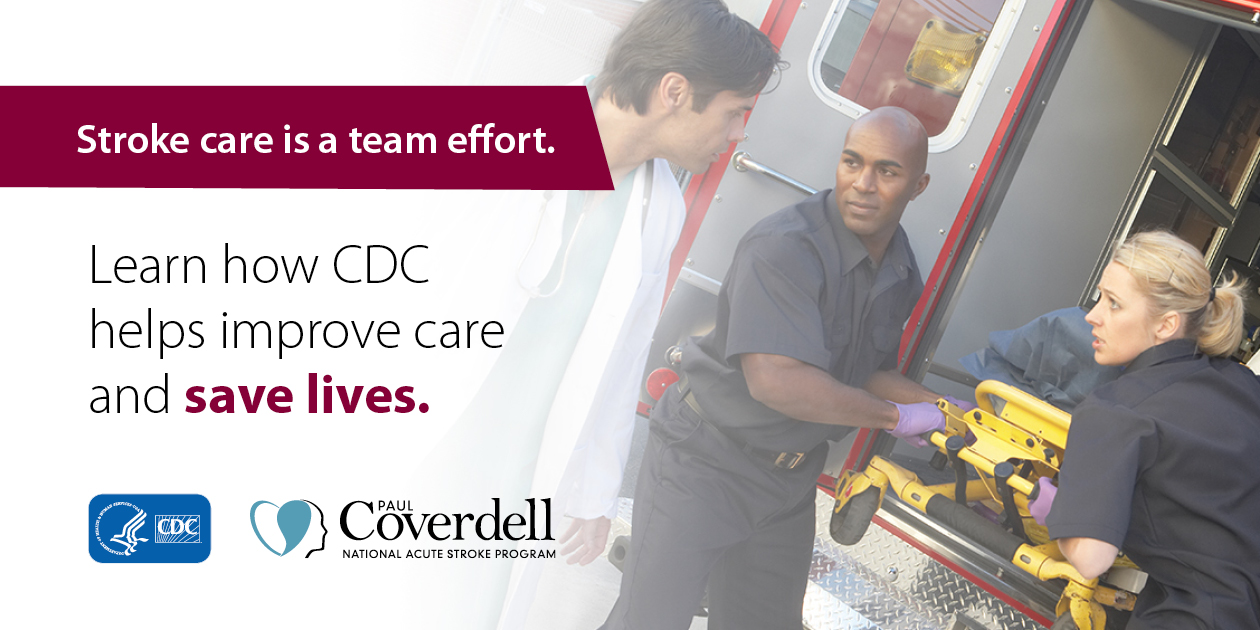Stroke Communications Kit
With the support of health professionals like you, DHDSP is better able to educate the public about stroke prevention. The social media messages and graphics below can help your audiences understand the basics of stroke, including signs and symptoms, the importance of a F.A.S.T. response during a stroke, and treatment. Help DHDSP spread awareness by sharing these resources on your social media pages.
Social Media Messages
Facebook/LinkedIn/Instagram/Pinterest
After decades of declining rates of stroke deaths, progress in preventing stroke deaths in the U.S. has slowed. The good news? YOU have the power to make a difference. Explore stroke data and prevention strategies for health systems, health professionals, and state health departments. http://bit.ly/2vUKTA4External

Raise awareness of the importance of stroke prevention all year long.
October 29, 2018: World Stroke Day (#WorldStrokeDay)
May 2019: National Stroke Awareness Month (#StrokeMonth)
May 19–25, 2019: National EMS Week (#EMSWeek)
- Time lost is brain lost. Every minute counts when you or someone you know is having a stroke. Act F.A.S.T. and call 9-1-1 right away if you think someone might be having a stroke. http://bit.ly/2oQE283External
- Stroke is a leading cause of death and disability nationwide and around the world—but it doesn’t have to be. Learn how you can treat and prevent stroke with tools from CDC [tag]. http://bit.ly/2oJOwleExternal
- Every 40 seconds, someone in the U.S. has a stroke. Health systems and health care professionals can help reduce stroke deaths by addressing risk factors and improving patient outcomes when stroke occurs. http://bit.ly/2vUKTA4External
- From the first symptoms of stroke to recovery at home, here’s how the CDC [tag] Coverdell Program connects health care professionals across the system of care to save lives and improve care. http://bit.ly/2ovTdlhExternal
- A stroke can happen at any age, at any time—just ask these 10 survivors. Read their stories about how stroke changed their lives. http://bit.ly/2HVJJejExternal
- Up to 80% of strokes are preventable. Reduce #stroke deaths in your community with prevention and treatment strategies from @CDCgov. http://bit.ly/2vUKTA4External @CDCHeart_Stroke
- Recognizing the signs and symptoms of a #stroke F.A.S.T. can help save lives. Here’s how. http://bit.ly/208s3wkExternal @CDCHeart_Stroke
- Every 3 minutes and 45 seconds, someone dies of #stroke. Learn how you can prevent a stroke or lower your chances of having one. http://bit.ly/2hSXBY9External @CDCHeart_Stroke
- Health systems and health care professionals can prevent #stroke by addressing risk factors and improving patient outcomes when stroke occurs. http://bit.ly/2vUKTA4External @CDCHeart_Stroke
- Learn how the @CDCgov Coverdell Program works to improve access and care for #stroke patients nationwide. http://bit.ly/2ovTdlhExternal @CDCHeart_Stroke
- A #stroke can happen at any age, at any time—just ask these 10 stroke survivors. Read their stories. http://bit.ly/2HVJJejExternal @CDCHeart_Stroke
Shareable Graphics
Download these stroke graphics to share on your social media pages. You can also visit the Million Hearts® Facebook video library, where you can share our videos and animated infocards with a click of a button!
Published October 26, 2015
When someone is having a stroke, every minute counts. Just as putting out a fire quickly can stop it from spreading, treating a stroke quickly can reduce damage to the brain. If you learn how to recognize the telltale signs of a stroke, you can act quickly and save a life—maybe even your own.
Published October 27, 2015
The Paul Coverdell National Acute Stroke Program, implemented by the Centers for Disease Control and Prevention, tracks and measures acute stroke care in order to improve the quality of care, from first contact with emergency medical services to the hospital and after the patient returns home from the hospital. The program works to improve stroke care nationwide and reduce stroke complications and deaths, particularly among those with the highest burden.
Published April 26, 2016
As the lead neurologist for the Coverdell Stroke Program in Georgia, Dr. Michael Frankel engages hospitals to participate in Georgia’s stroke registry. Participating hospitals better connect the continuum of care so that physicians have more information to make the right decisions every time. The data show that stroke death rates are lower in the communities served by hospitals that embrace practices supported by Coverdell.
Published October 27, 2015
As the lead neurologist for the Coverdell Stroke Program in Georgia, Dr. Michael Frankel engages hospitals to participate in Georgia’s stroke registry. Participating hospitals better connect the continuum of care so that physicians have more information to make the right decisions every time. The data show that stroke death rates are lower in the communities served by hospitals that embrace practices supported by Coverdell.
Published October 27, 2015
Every 40 seconds, someone in the U.S. has a stroke. One of those people was Prince Quire, who is African American. At only 39 years old, he was younger than the typical stroke patient, but EMTs know that a stroke can happen at any age. Stroke is the fifth leading cause of death for all Americans, including African Americans, but African Americans are twice as likely to have a stroke as whites are.
Published April 17, 2015
Blanche is a CDC employee who smoked cigarettes for more than 25 years and quit after suffering a stroke.
Visit CDC’s Tips From Former Smokers web site for more information.
Quiz
- Can You Spot the Signs and Symptoms of a Stroke?External
Share this quiz to test whether your audiences can recognize stroke signs and symptoms.
Additional Resources
- DHDSP Twitter and Million Hearts® Facebook pages
Follow DHDSP and Million Hearts® on social media to share our stroke posts directly on your pages. - Stroke and You Fact Sheet Series
Print and share these resources with your audiences to help them make healthy lifestyle changes and control health conditions that raise their risk for stroke. - Stroke Survivor Stories
Read these survivor stories to learn how you may be at risk for stroke and what to do if stroke happens. - Three Steps to Stroke Recovery
This CDC Features article talks about what to expect if you are recovering from stroke and how to prevent another stroke from happening. - World Stroke Day: We Can Prevent Stroke
This CDC Features article highlights the importance of stroke prevention. - Pregnancy and Stroke: Are You at Risk?
This CDC Features article discusses the connection between pregnancy and stroke and what you can do to keep yourself and your baby healthy. - Paul Coverdell National Acute Stroke Program (PCNASP)
Learn how the PCNASP helps CDC provide funding and support to state health departments to track and measure acute stroke care and improve the quality of care. - Million Hearts® Cardiac Rehabilitation Change PackageExternal
Download the change package for change concepts, change ideas, and tools and resources to improve cardiac rehabilitation participation rates among eligible patients. - Stroke Maps and Data
Find state-level data and maps to localize your media work. - Smoking and Heart Disease and Stroke, Your Guide to the 50th Anniversary Surgeon General’s Report on Smoking and HealthCdc-pdfExternal
Learn about the connection between tobacco use, secondhand smoke, and stroke risk.






